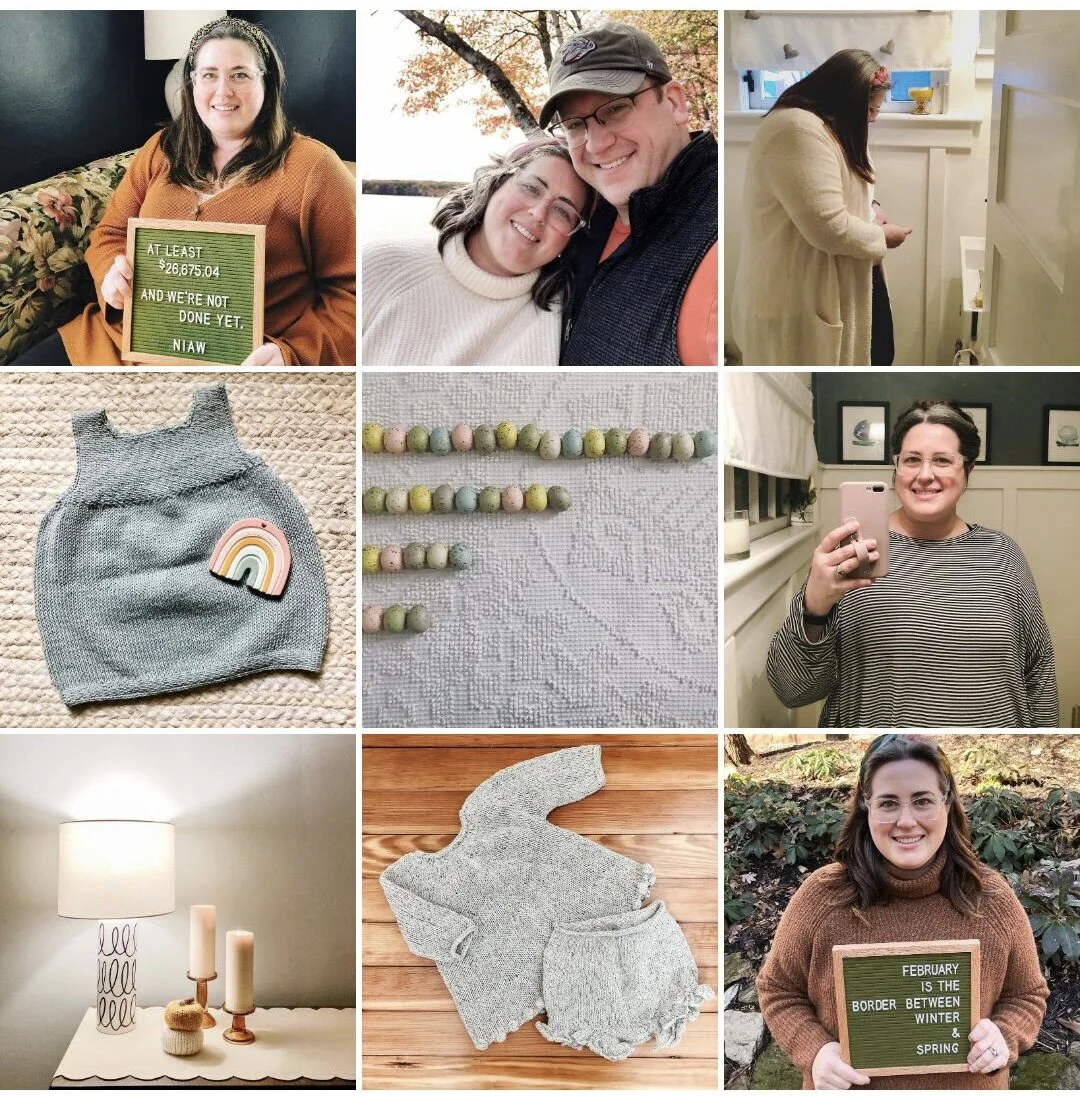Our Infertility Journey: Part Six
/Infertility impacts approximately 15% of couples in America and is a result of abnormal functioning of the male or female reproductive systems. Because I have Polycystic Ovarian Syndrome (PCOS), I live with one of the most common causes of infertility in women.
To be clear, my goal with these posts is to be open. Since we began fertility treatments in 2017 I've done a lot of searching to find experiences and stories from women living with PCOS and/or going through fertility treatments, and so far I haven't come up with much. Because I want to hear about what other women are experiencing, I am sure that others out there feel the same. While I know this is my story, I hope that by sharing it openly I will help someone else through whatever they are experiencing.
Since my last update on our journey last August, we’ve finally made some progress, friends - we have completed our first round of IVF! Now, there are a few things that happened leading up to that milestone, so let me catch you up.
Making a change
At the end of 2019, I felt like I had reached a breaking point with our infertility treatment journey. In this post I shared some of the tips I was using to cope throughout the holiday season, but something inside of me really felt like it was time for a change. Around that time, I asked someone that I follow in Instagram who was pretty public about changing fertility clinics what had prompted her to do so. We chatted back and forth about how she made that decision, and I realized that I was ready to do the same.
You see, in this whole year of knowing that IVF was the next step and having that initial consultation with our old doctor, I never heard from her or a member of her team again. We went eleven months without contact, and I decided that wasn’t what I wanted from my treatment experience anymore. I wanted a doctor that openly cared about our situation and was willing to do whatever they could to help us achieve pregnancy and hopefully start a family. I wanted to feel like a person instead of a number. So in January 2020, I went back to my fertility clinic research, got some feedback from other women in the area, and made the decision to switch to a new doctor.
A fresh start
I sent the request for a new patient appointment in the second week of January. Two weeks later, we had our initial consultation with a new doctor. He reviewed our history, expressed his sadness and frustration that we (in his opinion) had our time wasted by doing so many Clomid cycles at our previous clinic, and really clearly laid out the options that he thought we had. Given that we had mentally been preparing to start IVF for a year at this point, Kurt and I didn’t hesitate when he asked us what we wanted to do. We wanted to do IVF and we wanted to start as soon as possible. He said, “Alright, let’s go!”
Two weeks after that first appointment, we were back for IVF orientation. A member of the nursing staff walked us through all of the steps of the process: reviewing the medications that I would likely be prescribed, the time frame that stimulation would likely take, the role PGT testing could play for us, and so much more. None of it was necessarily new information to us, but to have someone walk us through step by step was so helpful to officially start this process.
After another brief two week wait, we returned for IVF shot training. During this appointment, another member of the nursing staff walked us through exactly how to mix, draw, and administer the different types of injections that I would take as a part of the stimulation process. It was at this appointment that things actually began to feel more real - I knew what it was like to hold a syringe and draw up the medication. I knew the size of the needles that would be used for each shot. I understood the importance of being precise with each measurement. And most of all, I actually felt like I could do this part of the IVF process and do it well.
Another two weeks after IVF shot training, I went back for one last appointment to have a hysteroscopy. In this procedure, a long, thin, lighted camera is inserted into the uterus through the vagina. That camera projects an image onto a screen, allowing the doctor to see inside the uterus. The procedure is typically done for IVF patients to identify if there are any problems with the uterus that would impact an eventual transfer. If so, additional procedures can be done to remove obstructions and make sure that all is well before moving on in the process. This was the first time I underwent this procedure, and to be honest, it is something I will never forget! I loved being able to see the inside of my uterus - it gave me a greater appreciation for just how amazing our bodies are. And for someone who has had such a difficult time with infertility, learning that my uterus was without problems gave me a sense of security for when we get to the transfer part of this IVF process.
After my appointment and the hysteroscopy we took a quick trip to the pharmacy and picked up everything that I would need for the next two weeks. That afternoon when I got home, I took my first injection!
IVF during a global pandemic
I started injections on March 9. Two days later, the WHO had declared the COVID-19 virus a global pandemic. Everything that had been certain was now a little bit less so.
At my first monitoring appointment, I was reassured that, because we had already started my cycle, it was unlikely that we would be asked to stop. That didn’t stop me from wondering if this would all be for nothing every time I gave myself an injection. With each monitoring appointment the office put new restrictions into place to limit the number of people coming in and out of the office. First, partners and support persons were asked to not attend appointments so that the waiting room had less people in it throughout the day. Then, they started taking the temperature of every individual that came into the office - patients and staff. Somehow it was unnerving and comforting at the same time. I knew they were taking every precaution to keep patients currently in treatment on the right path, but it was still eerie to see fewer and fewer people in the office each time that I went.
I gave myself injections twice a day from March 9 until March 24 and had monitoring appointments on March 13, 16, 19, 21 and 23. In addition to the concerns about COVID-19 making me nervous, I also wasn’t responding as well to the medications as my doctor had thought I would. My ovaries were showing lots of follicles, but they took forever to grow to a size that would indicate a mature egg was inside. Given my slow response, I needed to stimulate for longer than was originally planned. This necessitated purchasing more of the medication midway through so that I had enough to last me the entire time it needed to. At my last two monitoring appointments the nurses also talked with me about the possibility of canceling the cycle because I wasn’t responding very well. But my doctor felt confident that we would get a handful of eggs based on where I was measuring at my last monitoring appointment and encouraged me to keep going. On March 24 at 9:30pm my mom administered the trigger shot (Kurt didn’t feel comfortable sticking me with a 1.5 inch long needle - I’m not sure I blame him!) and on the morning of March 26 we had our egg retrieval!
waiting for results and next steps
A quick selfie before my egg retrieval!
I went into the egg retrieval expecting to only get five or six eggs based the measurement of my follicles at the last monitoring appointment. Even though I had been given a few extra days to stimulate, there was no guarantee that extra time or medicine would help. So you can imagine our surprise when the procedure nurse told me that we actually got 17 eggs! The procedure requires patients to be put under light anesthesia so I couldn’t hear or see everyone’s reactions during the egg retrieval, but the nurse said that there was so much excitement when they realized how much everything had grown since they had seen me last.
Following the egg retrieval, it was another few days of waiting as the embryologists check, fertilize, and monitor the eggs. Updates were given to us from the embryologist lab on Day 1, Day 3, Day 5, Day 6, and Day 7. Here’s a breakdown of our numbers:
17 eggs were retrieved.
Of those 17 eggs, 10 of them were mature and were combined with Kurt’s sperm using ICSI.
We found out the day after the egg retrieval that of those 10 eggs that were combined with sperm, 6 of them fertilized. That is considered Day 1 for the embryos.
On Day 3, we learned that of those 6 embryos, 4 of them were growing right on schedule, 1 was growing about 12 hours behind, and 1 was not yet growing.
On Day 5, we learned that all 6 of the embryos were growing and were in between the compacting and blastocyst stages, but none were ready to be biopsied and frozen yet. So we waited until Day 6 for another update.
On Day 6, we learned that 3 of the embryos had made it to the blastocyst stage and were ready to be biopsied and frozen! The biopsied cells would be sent for genetic testing and the embryos would be frozen until we knew the results of that testing and could potentially move forward with a transfer. The remaining 3 embryos were really close to being ready for biopsy as well, so the embryologists watched them for one more day and called us with another update on Day 7.
On Day 7, we learned that 1 more of the embryos had made it to blastocyst stage and would also be biopsied and frozen! The remaining 2 embryos were discarded because they had stopped progressing.
So now, as we start the fourth year of trying to start our family, we are just waiting for the results of the genetic testing for our final four embryos to come back! There is something that feels a bit serendipitous in all of this - four years of trying, four embryos being tested - that is giving me hope. And even though we will need to wait a bit longer before we can schedule our transfer, it feels so good to be so much closer to starting a family than we ever have been before.
Friends, if there is one piece of advice I’ll offer to you from the experience of changing doctors, it’s to not be afraid to check in on how you’re doing in your own life - what isn’t sitting right with you that you might want to explore changing? It could be a relationship, a doctor, a job, where you live, or something that you might not even realize you’re unhappy with until you do a bit of digging. Think about it, and if you want someone to talk to as you explore this, just let me know. I’m here for you!















